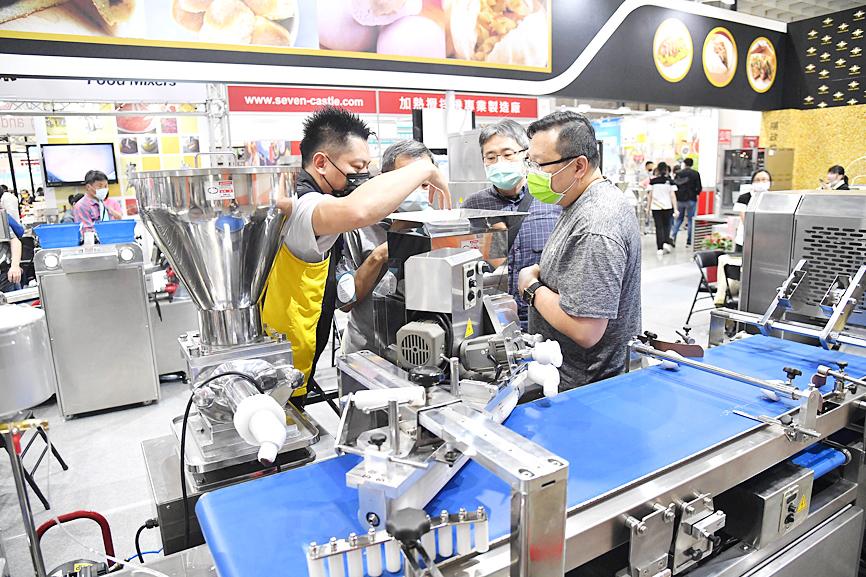The government’s business climate monitor last month remained “yellow-red,” as imports of machinery equipment and manufacturing sales slackened somewhat, the National Development Council (NDC) said yesterday.
The overall score of all constituent readings shed two points to 34, showing that the nation’s economy remains vibrant, although the pace of growth lost some momentum, NDC research director Wu Ming-huei (吳明蕙) said.
The council uses a five-color system to depict the nation’s economic state, with “green” indicating steady growth, “red” suggesting a boom and “blue” signaling a recession. Dual colors indicate a shift to a stronger or weaker state.

Photo: CNA
“I am confident that Taiwan’s GDP growth should exceed 4 percent this year in light of robust exports, industrial production and manufacturing sales,” Wu told a media briefing.
“Green” and higher signals on the system suggest robust economic conditions, aided by active private investment, Wu said.
The official attributed the mild slowdown to uncertainty over regional geopolitical tensions, and soaring international energy and raw material prices, which are casting a shadow on the global economic landscape.
Worsening inflation has led global research bodies to trim their GDP growth forecasts for the US and Europe, Wu said, adding that rising crude oil prices would increase production costs, constrain corporate profits and affect the economy in Taiwan.
The index of leading indicators, which aims to portray the economic situation in the coming six months, shrank 0.64 percent from a month earlier to 100.65, as all seven constituents fell, the council said.
Wu said the trend is not a sign of economic downturn, but agreed that a slowdown is occurring, which she said needs to be closely monitored.
The council expects to pay particular attention to whether the war between Russia and Ukraine dampens Taiwan’s export orders, she said.
Commentators have downgraded the target prices of technology shares on concern that higher inflation could deter people from buying consumer electronics products.
The war’s effects could become more evident soon, beyond ongoing financial market swings and energy price hikes, Wu said.
The index of coincident indicators, which reflects the current economic state, expanded 0.32 percent to 102.99, as the indices for employment, industrial output and exports, as well as wholesale, retail and restaurant revenues picked up, the council said.
However, manufacturing sales and power consumption as well as imports of electrical and machinery equipment showed negative cyclical movements, it said.

JITTERS: Nexperia has a 20 percent market share for chips powering simpler features such as window controls, and changing supply chains could take years European carmakers are looking into ways to scratch components made with parts from China, spooked by deepening geopolitical spats playing out through chipmaker Nexperia BV and Beijing’s export controls on rare earths. To protect operations from trade ructions, several automakers are pushing major suppliers to find permanent alternatives to Chinese semiconductors, people familiar with the matter said. The industry is considering broader changes to its supply chain to adapt to shifting geopolitics, Europe’s main suppliers lobby CLEPA head Matthias Zink said. “We had some indications already — questions like: ‘How can you supply me without this dependency on China?’” Zink, who also

The number of Taiwanese working in the US rose to a record high of 137,000 last year, driven largely by Taiwan Semiconductor Manufacturing Co’s (TSMC, 台積電) rapid overseas expansion, according to government data released yesterday. A total of 666,000 Taiwanese nationals were employed abroad last year, an increase of 45,000 from 2023 and the highest level since the COVID-19 pandemic, data from the Directorate-General of Budget, Accounting and Statistics (DGBAS) showed. Overseas employment had steadily increased between 2009 and 2019, peaking at 739,000, before plunging to 319,000 in 2021 amid US-China trade tensions, global supply chain shifts, reshoring by Taiwanese companies and

Taiwan Semiconductor Manufacturing Co (TSMC, 台積電) received about NT$147 billion (US$4.71 billion) in subsidies from the US, Japanese, German and Chinese governments over the past two years for its global expansion. Financial data compiled by the world’s largest contract chipmaker showed the company secured NT$4.77 billion in subsidies from the governments in the third quarter, bringing the total for the first three quarters of the year to about NT$71.9 billion. Along with the NT$75.16 billion in financial aid TSMC received last year, the chipmaker obtained NT$147 billion in subsidies in almost two years, the data showed. The subsidies received by its subsidiaries —

At least US$50 million for the freedom of an Emirati sheikh: That is the king’s ransom paid two weeks ago to militants linked to al-Qaeda who are pushing to topple the Malian government and impose Islamic law. Alongside a crippling fuel blockade, the Group for the Support of Islam and Muslims (JNIM) has made kidnapping wealthy foreigners for a ransom a pillar of its strategy of “economic jihad.” Its goal: Oust the junta, which has struggled to contain Mali’s decade-long insurgency since taking power following back-to-back coups in 2020 and 2021, by scaring away investors and paralyzing the west African country’s economy.